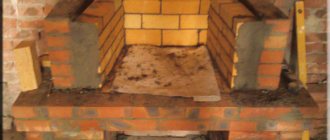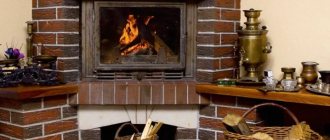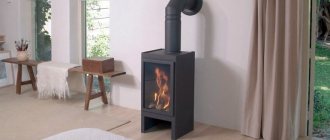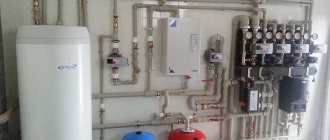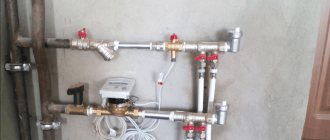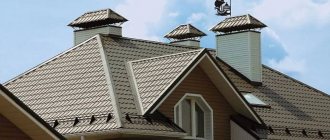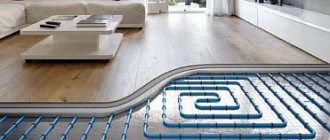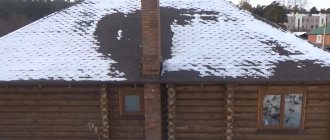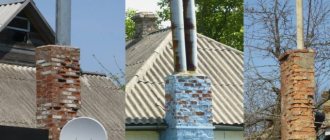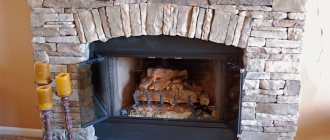The quality of the chimney can be easily assessed while the fireplace is operating. If there is no smell of smoke in the room with the fireplace, and the wood ignites immediately, the chimney for the fireplace was correctly designed and installed. Let's figure out what materials a chimney system can be assembled from and how to calculate the parameters of the chimney duct so that it fulfills its purpose.
Chimney parameters are determined at the design stage Source mypropertyadvice.com
Characteristics important for a chimney
The main requirement for the chimney system of any device, stove, fireplace or boiler is to ensure high-quality ventilation of the combustion chamber. The draft, which removes the products of fuel combustion outside, is formed due to the temperature difference when hot air rises through the chimney channel and cold air comes in its place.
The removal of flue gases can be organized in different ways, so chimneys are constructed from different materials, the shape and size also differ. At the same time, all the variety of structures is designed according to certain rules and is subject to strict laws.
Chimneys made of different materials have design differences, but all fireplace pipes are designed based on the following considerations:
- The draft must be sufficient to prevent combustion products from entering the room.
- In a properly selected design, a minimum of soot is deposited on the walls.
- The material is selected taking into account the temperature of the flue gases. The maximum temperature is maintained in the firebox; at the exit from the pipe it drops slightly, but can reach +100°C.
Steel has excellent performance characteristics Source superdom.ua
- Critical indicators of the chimney are its height and internal diameter; they are necessarily taken into account in the calculations.
- During the operation of the fireplace, soot settles in the chimney. Its excessive accumulation is undesirable, as it makes it difficult for gases to escape, and the rate of accumulation increases all the time. The design should provide for the possibility of convenient cleaning (this is carried out when the fireplace is not in use).
- Provisions must be made to monitor the integrity of the internal surface and connections of the structure. Cracks and irregularities that arise impede the calculated circulation of hot air.
Stainless steel smoke exhaust structures
Chimneys for fireplaces of this type are stacked structures. The length and diameter of a stainless steel fireplace pipe can be very different. Such products are often produced complete with ceramic ones and placed inside steel ones.
Chimneys made from galvanized stainless steel have the following advantages:
- they can be installed without a foundation, since they are light in weight;
- assembly and installation of the structure is permitted after completion of construction;
- they are cheaper in cost than block and ceramic systems;
- If necessary, replacing individual elements will be easy.
The disadvantage of steel chimneys is the need for a design solution in the case of interior design, if such a structure is installed indoors.
SNiP about the installation of a fireplace
The construction of fireplaces is regulated by SNiP rules; they contain all the information needed when independently designing a chimney system for a fireplace. The rules draw attention to the fact that the ventilation duct and chimney have different purposes, and they cannot be combined into one system.
Installation of a fireplace must comply with SNiP 41-01-2003 Source tinkoffjournal.ru
In a private house with a fireplace, it is necessary to provide forced exhaust ventilation and, separately from it, forced supply ventilation. Only in this way can a constant and sufficient level of draft be ensured, as well as avoid the entry of flue gases into the room.
The internal size of the chimney for a fireplace is a parameter for which the minimum acceptable values are specified in SNiP. They depend on the pipe material and the power of the heating device. For concrete and brick pipes the ratios are as follows:
- If the device power does not exceed 3.5 kW, the minimum permissible cross-section is 140x140 mm (round cross-section from 160 mm).
- For power in the range of 3.5-5.2 kW: cross-section from 140x200 mm.
- Power from 5.2 kW: from 140-270 mm (for round from 220 mm).
With the same power parameters for steel and ceramic structures, the minimum sections are increased to, respectively, 160, 190 and 220 mm.
The height of the chimney is an important detail for organizing good draft, so it is described in detail using the following conditions:
- The minimum permissible length of the structure is 5 m (meaning the distance from the grate to the pipe outlet).
Determining the height of the chimney Source s-proms.ru
See also: Catalog of companies that specialize in the design and installation of fireplaces and stoves
- Longer structures are possible, which depends on external parameters (for example, on the characteristics of the roof, the location and height of neighboring buildings).
- For a flat roof, a chimney with a height above it of at least 0.5 m is calculated.
- Closely located obstacles impair traction. Such an obstacle can be the ridge or parapet of a pitched roof. If the distance to them is less than one and a half meters, the fireplace chimney is designed above the obstacles by at least 50 cm.
- If the chimney is located on a pitched roof far from obstacles (more than 3 m), its height is calculated from a conventional line drawn from the ridge down at an angle of 10º.
SNiP pays a lot of attention to brick structures, which are especially often chosen for decorating a fireplace in a private home. If you want your fireplace to have a brick chimney, it must comply with the following conditions:
- The wall thickness is at least 120 mm (concrete walls, for example, can only be 60 mm).
- In a brick (and concrete) chimney system, inspection openings with doors for cleaning are designed.
- To reduce the accumulation of soot in the channel, it is preferable to make it vertical throughout its entire length, without protrusions or slopes.
Fireplaces with open fireboxes require increased safety standards Source pinimg.com
- If it is impossible to make the structure vertical (for example, you need to bypass the beam), organize a tilt. It cannot be longer than 1 m, the angle of inclination should not exceed 30° or change the specified diameter of the chimney.
Separate rules relate to ensuring fire safety when operating a wood-burning fireplace:
- The device is placed against the wall to properly install the pipe.
- The walls and ceiling around the structure are protected with fire-resistant materials (sheet metal, plaster, asbestos). The wall through which the chimney passes is insulated from the outside. There should be no wooden elements (beams) in the floor structure.
- It is extremely important to maintain a gap between the brick wall and the ceiling: at least 13 mm (including thermal insulation). For example, for ceramics the gap increases to 25 cm.
- Before the firebox, a sheet of steel (or brass) measuring 50x70 cm is laid on the floor. The firebox sheet not only protects the floor, but also simplifies cleaning.
- The minimum distance from the firebox door to the opposite wall is 125 cm.
- The door for the firebox can be made of metal or glass, but always made of fire-resistant glass.
The door glass must be heat resistant Source amazon.com
Disadvantages of brick structures
A smoke exhaust pipe for a brick fireplace has disadvantages, the main one being the short service life of such structures, which does not exceed 7 - 10 years. The fact is that frequent and significant temperature changes during the cold season lead to the appearance of condensation, and it either freezes or thaws. As a result, over time, the brickwork begins to collapse.
To reduce the impact of negative aspects you can:
- expand the cross-section of the external chimney walls to 25 centimeters in those places where they are above the roof surface;
- insulate these sections of the chimney with mineral slabs.
The chimney pipe will last longer if you install a cap on top of it, which will protect it from precipitation.
One of the significant disadvantages of brick chimney structures is the presence of a rough inner surface, since this circumstance leads to a decrease in draft efficiency compared to smooth pipe walls.
Designing smoke drainage through a chimney that has a certain reserve cross-sectional area can help cope with this problem. The installation of galvanized steel pipes inside the smoke exhaust system will also increase the service life.
Materials
When choosing material for a fireplace and chimney, owners are guided by regulatory requirements, the size of the construction budget, the size of the chimney and their own tastes. In private homes there are fireplaces with chimneys made of the following materials:
- Ceramics . Ceramic chimneys are ideal for wood-burning fireplaces. They are compact and durable, are not afraid of overheating, are not destroyed by condensation, and have smooth inner walls. The disadvantages include their high cost, heavy weight (you will have to take care of reinforcing the floor), and complicated installation.
Ceramic components for chimney systems Source strojdvor.ru
- Brick . A traditional, time-tested material, which means a wide choice of masonry technology and pipe construction method. Problems with operation may arise if the seams between the bricks are not sealed and irregularities remain inside the pipe. Consequently, the skill of the performer comes first, and this is a parameter that is difficult to assess in advance.
- Steel . For the manufacture of pipes, heat-resistant anti-corrosion steel is used; steel products are chosen if the gas temperature does not rise above 400°C. The design is light, the floor does not need to be reinforced, and installation takes little time. More expensive steel pipes are equipped with thermal insulation (sandwich pipes) and are sold in ready-made kits, convenient for self-assembly.
Components for sandwich pipes Source strojdvor.ru
- Glass . The stylish design is made of heat-resistant glass, inert to the corrosive effects of smoke. Advantage of glass: soot settles more slowly on a smooth surface, which means less frequent cleaning. Due to its unusual appearance, high price tag and complex assembly, this option is rarely in demand, although its performance is comparable to its ceramic counterparts.
Experts recommend
Note! Calculating a chimney is a rather complex task, as it requires specialized engineering knowledge and taking into account many technical parameters. Regional professionals recommend ordering a calculation of the smoke and combustion products removal system from regional specialists.
provides a full range of services for professional calculation of the chimney route and the equipment connected to it:
- visit of a specialist to identify and take into account all technical and engineering parameters of the structure, connected heating equipment, and customer wishes
- preparation by the company's engineering department of a detailed technical plan, including all calculations, main, components and components of the smoke exhaust system
- preparation and calculation of estimates, agreement with the customer
- order and delivery of equipment
- departure of a team of professional installers to install the chimney string, its components, fasteners, connections to the stove, fireplace, boiler
- commissioning of smoke removal and heating systems, checking systems, advising the customer on the correct operation of the equipment
- drawing up a certificate of acceptance of installation work and providing warranty obligations
Engaging professionals to calculate and install a chimney for any type of heating equipment is a reliable guarantee of fire and operational safety of utility networks, safety of property and health of home residents, efficient and long-term operation of heating and smoke exhaust equipment.
Diameter calculation principle
Diameter and height parameters are important for the functioning of the fireplace. If you select them incorrectly, you may encounter backdraft, and this already makes the operation of such a device dangerous for home owners.
In SNiP, the diameter of the pipes is determined by the power of the device (through the consumption of solid fuel and the volume of exhaust gases), but it is often necessary to calculate a more accurate pipe size. There are several methods for such calculations:
- According to formulas. The most accurate method, but it involves not only calculations, but also the determination of quite specific parameters (for example, the solid fuel combustion rate coefficient is pre-selected from table No. 10 of GOST 2127).
The volume of the firebox determines the amount of smoke Source pinimg.com
- According to schedule (Swedish method for open fireplaces). The diameter of the chimney for a fireplace is determined by the area of the combustion compartment, since the graph establishes the relationship between these values.
- Approximate. For a chimney with a round cross-section and an open firebox, a diameter ratio of 1:10 is used. For example, for a firebox measuring 40x50 cm, the permissible diameter will be: (40+50)x2/10=18 cm.
- For a chimney with a square cross-section, a ratio of 1:1.5 is used (this is due to the occurrence of smoke turbulence), and the minimum cross-sectional size will be 12x12 cm.
Installation of a steel chimney with a round cross-section Source maximuscentr.com.ua
Serious engineering solution
Calculating chimneys for a house or bathhouse is a complex engineering task. If you are not a specialist and you have a question about how to calculate a chimney for your home, use special programs that make it easier for you to make the correct calculation - be it the height, cross-section or length of the chimney.
In order to make correct calculations, it is necessary to know the structure and physical properties of materials, thermodynamics, and aerodynamics.
If you do not plan to further connect your life with the construction and design of chimneys, contact specialists. After all, the comfort of your home, safety and, most importantly, health, and sometimes life - yours and your loved ones - depend on the correct operation of the chimney.
Old school stove makers considered the ratio of the dimensions of the fireplace portal to the chimney to be 1:10 or 1:13. Depending on the operating conditions of the fireplace and weather conditions. Tabular fireplace calculation data are considered more accurate.
Table 6.1. Correlation of fireplace parameters (according to Sh. K. Afanasyev)
Pipes for fireplaces (three types of sections)
Flow section in bricks No.tr
Flow section in bricks No. tr
How to use table 6.1.
A is the width of the firebox,
B – height of the fireplace firebox,
column 3 – round standard chimney pipes, 4 – height of chimney pipes, 5 – dimensions of the firebox of the fireplace, 6 – height of the chimney pipes, 7 – dimensions of the firebox, 8 – height of the chimney pipes.
The ratio of the mirror of the fireplace portal, the cross-section and height of the chimney are directly dependent. Suppose you need to calculate a chimney based on the mirror of the fireplace portal with sides 1020x770. We search according to the table and find: diameter 300 mm, pipe height 9.5 meters.
Diagram 1.
Rice. 6.5 (A). Diagram for calculating the fireplace portal and pipe cross-section, where H is the height of the pipe in meters, F is the area of the fireplace portal (dimensions A and B in cm2; f is the cross-sectional area of the pipe (flow area in cm2; (f/ F) X100 is the percentage of area f from area F.
The configuration of the pipe sections is shown above.
How to use the diagram. Rice. 6.5(A). The horizontal numbers indicate (as a percentage) the area of the chimney pipe (f) to the area of the fireplace portal (F).
For example. The fireplace portal is 77 cm x 63 cm, therefore, the portal area is F = 4851 cm2. The dimensions of the square chimney pipe are 25cm x 25cm, therefore the cross-sectional area of the pipe is f = 625 cm2.
(f/ F) X100= 625/4851x100=12.8%.
Using a horizontal scale, we find the straight line until it intersects with the curve of the diagram (the middle line of a square chimney) and find the height of the chimney. The height of the chimney is 5 meters.
Let's consider other options for the ratios and dimensions of the fireplace. If you compare these tables, they are all approximately the same. There are small adjustments for: the roughness and cleanliness of the surface of the chimney walls, the angle of inclination of the outlet, the height of the pipe, the presence of nearby trees and buildings.
To determine the parameters and dimensions of the portal and chimney pipe of the fireplace, various factors are taken into account: the temperature of the flue gases, the speed of the exhaust gas-air mixtures (0.25 m/sec), the cleanliness of the channels, air pressure, etc. A round cross-section is considered better than a square cross-section, and a square cross-section is considered better than a rectangular cross-section. The air supply to the firebox of the fireplace is the main criterion in ensuring reliable operation of the fireplace. Most often, this is achieved by balanced supply and exhaust ventilation in a cottage, where the windows and doors are made of sealed double-glazed windows. Ventilation should be excessive with air pressure of 12-14%. If there is no supply and exhaust ventilation in the room, then sometimes it is enough to open the window, or slightly open the transom of the window.
Rice. 6.6. Facade, section and plan of the fireplace with letter designation for calculating various fireplace options according to table 6.2
Table 6.2. The ratio of the cross-section of the fireplace portal and the chimney.
Fig.6.6(A). The ratio of the cross-section of the fireplace portal and the chimney.
Errors or even the slightest inaccuracies made at the chimney construction stage will ultimately lead to serious consequences
In view of this, it is extremely important to do everything in accordance with the requirements and standards. An incorrectly designed chimney for a fireplace with your own hands can cause serious financial losses, which will manifest itself along with the need to redo everything
Among the consequences may be fire or poisoning of people in the room by products of improper combustion. Correct calculation of the chimney for the fireplace will allow you to avoid these accidents and enjoy a pleasant pastime in a cozy home.
Diagram of an English fireplace with a straight chimney.
Proper laying and installation
The fact that the chimney must be installed correctly is even more important than installing the fireplace itself.
Errors in this case are unacceptable, because due to them not only the equipment may break down, but there may be a danger of carbon monoxide poisoning and even a fire.
In order to do everything correctly, an installation diagram must first be developed. For example, like this:
How to choose
It is difficult to unequivocally answer the question of which chimney to choose. There is a main rule here: the choice of a chimney should in no case be based on its cost. In this case, this is not the main thing. You need to start from the following things:
- depending on the selected heating type;
- on the type of unit you have chosen;
- on how the chimney will be installed. If you invite a specialist to do this, that’s one thing, but if you rely on your own strength, that’s a completely different matter; the job should be up to you;
- much will depend on the intensity with which your heating system will be operated.
Calculate everything and give a correct assessment of your knowledge and experience in installing a chimney, and then make your choice.
How to remove soot
It will be safe and comfortable to have a fireplace in the house only if there is good draft in the chimney. And this largely depends on his condition.
There are several cleaning methods for chimneys: there are traditional ones, which people have used for centuries, and modern ones, based on scientific developments. These methods include:
People's
In the old days, chimneys were cleaned with aspen wood, which could generate heat in the firebox up to 1200C. Under such influence, the soot becomes loose and burns, and everything that remains of it flies out along with the smoke into the chimney.
Before cleaning using this method, you must be sure that such high temperatures will not harm your chimney, since it will be difficult to avoid destruction or fire if the chimney, for example, cracks.
Even in the old days, they used another method of cleaning the chimney: they burned dried potato peelings, the combustion of which released substances that could loosen the soot, and then it was easily removed from the cleaning holes. But traditional methods will not always help, and in case of severe blockage it is better to turn to chemistry.
Chemical
Today, you can find a variety of cleaning products for cleaning chimneys in the stove store. It can be powder, tablets, liquid or special pellets, logs and briquettes, which are simply placed in the firebox (with or without firewood) and burned. More details about the use of each chemical are described in the instructions supplied with them.
Cleaning briquettes are considered the most convenient of all chimney cleaning chemicals. They heat the fireplace for about two hours, due to which the substances that bind the soot in the chimney are destroyed, and the remaining fines are carried out, like the smoke, into the chimney.
If there was a large blockage in the pipe, it will fall down, and therefore, after servicing the chimney, an inspection of the entire chimney space is necessary, for which there are special doors.
Mechanical
This method is the most effective and will cope with the most serious blockage, which occurred due to a severe narrowing of the lumen or due to some debris getting into the pipe.
Chemistry may not be able to change anything here.
And operating such a fireplace is dangerous not only for health, but also for life - all the deposits formed inside the chimney can catch fire, not only smoke, but also sparks and even fire can escape from the chimney.
If the weather is dry, there is a high probability of a fire, so if there is no draft and the room begins to fill with smoke, mechanical cleaning of the chimney using special tools and devices will be required.
Devices designed for mechanical cleaning of a fireplace chimney from soot and soot include special scrapers, brushes, brushes of different sizes and configurations, and weights in the form of cores to break through dense blockages.
All this is on sale, but you can do a lot yourself.
It may not be necessary to clean the chimney often, but if the soot deposit inside the chimney exceeds 2 mm, then it’s time to work as a chimney sweep.
2,019 views
